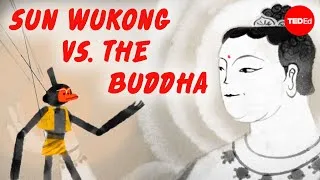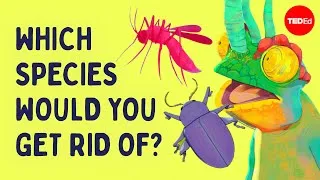請雙擊下方英文字幕播放視頻。
譯者: Lilian Chiu
審譯者: SF Huang
00:07
If you were to place all the rice consumed
each year on one side of a scale,
0
7003
4212
如果你把每年消費的稻米
放在天秤的一端,
00:11
and every person in the world
on the other,
1
11215
2211
世界上的所有人放在另一端,
00:13
the scale would tip heavily
towards rice's favor.
2
13426
2544
天秤會明顯傾向稻米的那一邊。
00:16
This beloved crop contributes over 20% of
the calories consumed by humans each year.
3
16095
5255
人類每年消費的卡路里有超過
20% 來自這種受歡迎的作物。
00:21
Korean bibimbap, Nigerian jollof,
Indian biryani, Spanish paella,
4
21934
5756
韓國的拌飯、奈及利亞的焗飯、
印度的沙拉、西班牙的燴飯,
00:27
and countless other culinary masterpieces
all begin with rice.
5
27690
4338
和其他無數烹飪佳餚
都從稻米開始。
00:32
So how did this humble grain
end up in so many cuisines?
6
32028
3211
這種不起眼的穀物,後來
是如何出現在這麼多菜餚中?
00:35
The roots of rice go back thousands
of years to when early farmers
7
35990
3128
稻米的起源可以追溯到數千年前,
亞洲、非洲和南美洲早期的農民
00:39
in Asia, Africa, and South America
each independently domesticated the crop.
8
39118
5172
分別都各自馴化了這種作物。
00:44
First came Asian rice,
9
44582
1502
首先出現的是亞洲稻米,
00:46
which many plant geneticists believe
originated in what's now China.
10
46084
3962
許多植物遺傳學家認為
它起源於現在的中國。
00:50
Over 10,000 years ago,
nomadic hunters in the region
11
50338
3211
一萬多年前,該地區的遊牧獵人
00:53
began gathering and eating seeds
from a weedy grass.
12
53549
3003
開始收集和食用一種野草的種子。
00:56
Then, around 9,000 years ago,
they started planting these seeds,
13
56761
4338
接著,約九千年前,
他們開始種植這些種子,
01:01
prompting nomadic hunters to settle
into farming communities.
14
61099
3586
讓遊牧獵人在農業社會中安頓下來。
01:04
With each harvest, growers selected
and replanted seeds
15
64811
2961
每次收穫時,
種植者會選出他們最喜歡的
稻米植物,重新種植其種子——
01:07
from the rice plants
that pleased them most—
16
67772
2252
01:10
like those with bigger and more plentiful
grains or aromatic flavors.
17
70024
4254
他們偏好比如米粒更大、
更豐富,或有芳香味道的植物。
01:14
Over millennia, thousands of varieties
of Asian rice emerged.
18
74654
3920
數千年間,有數千種亞洲稻米出現。
01:18
A relative of the same weedy grass
was also domesticated in Africa
19
78741
3962
同樣這種野草的親戚,
也在非洲被馴化,
01:22
around 3,000 years ago.
20
82703
1836
時間約為三千年前。
01:24
Today, its growth is mostly limited
to West Africa.
21
84872
3504
現今,它主要生長在西非。
01:28
South American growers also domesticated
rice around 4,000 years ago,
22
88501
4296
約四千年前,南美洲的
種植者也馴化了稻米,
01:32
though the crop was lost
after the arrival of Europeans.
23
92797
3378
不過在歐洲人抵達之後,
這種作物就不見了。
01:36
Asian rice, however, spread widely,
24
96384
2294
然而,亞洲稻米傳播得很廣,
01:38
and is now a cornerstone of diet
and culture in Asia and beyond.
25
98678
4129
現在,它已經是亞洲及其他地區
飲食與文化的基石。
01:42
In India and Nepal, many Hindus mark
an infant's transition to solid foods
26
102932
4588
在印度和尼泊爾,
許多印度教教徒用一種
叫做 Annaprashan 的儀式
01:47
with a ceremony known as Annaprashan,
27
107520
2336
來代表嬰兒開始吃固態食物了,
01:49
where the baby tastes rice
for the first time.
28
109856
2377
在儀式中,嬰兒初次嚐到稻米。
01:52
in Japan, rice is so central to diets
that the word "gohan"
29
112400
3587
在日本,稻米對飲食非常重要,
因此「ご飯」這個詞
01:55
means both "cooked rice" and "meal."
30
115987
2294
意義既是「熟飯」也是「進餐」。
01:58
The global expansion of rice cultivation
was only possible
31
118531
3170
稻米耕作之所以能擴展到全球,
02:01
because the plant can grow
in many climates—
32
121701
2335
是因為這種植物在許多氣候下
都能生長——從熱帶到溫帶。
02:04
from tropical to temperate.
33
124036
1836
02:06
As a semi-aquatic plant, rice happily
grows in submerged soils.
34
126164
4004
稻米是半水生植物,
喜歡在水下的土壤中生長。
02:10
Many other crops can't survive
in standing water
35
130418
2586
許多其他作物無法在積水中生存,
02:13
because their root cells rely on air
within soil to access oxygen.
36
133004
4546
因為它們的根細胞要仰賴
土壤中的空氣才能取得氧氣。
02:17
But rice plants have air channels
in their roots that allow oxygen to travel
37
137717
3962
但稻米植物的根部有氣道,
讓氧氣能從樹葉和莖部
傳送到水下的組織中。
02:21
from the leaves and stems
to the submerged tissues.
38
141679
3128
02:25
Traditionally, growers plant
rice in paddy fields—
39
145016
2919
傳統上,種植者會在水田中種稻——
02:27
flat land submerged under as much
as 10 centimeters of water
40
147935
3754
水田是平坦的土地,在生長季
上面約會有十公分深的水。
02:31
throughout the growing season.
41
151689
1460
02:33
This practice returns high yields
since many competing weeds
42
153274
3587
這種做法會帶來很高的產量,
因為許多競爭的野草
02:36
can't hack it in the aquatic environment.
43
156861
2210
無法在水生環境中生存。
02:39
But the technique is also water intensive.
44
159071
2378
但該技術需要大量的水。
02:41
Rice covers 11% of global cropland,
45
161657
2753
全球的農田有 11% 是種稻米,
02:44
but uses over a third
of the world's irrigation water.
46
164410
2961
但用水佔全世界
灌溉水的至少三分之一。
02:47
This form of rice production
also pumps out
47
167747
2294
這種形式的稻米生產還會
排放大量的溫室氣體。
02:50
a surprising amount
of greenhouse gas emissions.
48
170041
2502
02:52
Flooded fields are the perfect breeding
grounds for microorganisms
49
172710
3629
淹水的田地則非常適合
甲烷菌這種微生物繁殖。
02:56
known as methanogens.
50
176339
1501
02:58
These microscopic lifeforms thrive
in environments lacking oxygen,
51
178132
3921
這些微小的生命在缺乏氧氣的
環境中能夠茁壯成長,
03:02
because they evolved when the Earth
contained little of this gas.
52
182053
3170
因為它們是在地球沒什麼
氧氣的時候演化出來的。
03:05
Methanogens are the only organisms
known to produce methane—
53
185264
3712
已知的生物中,只有
甲烷菌會產生甲烷——
03:08
a greenhouse gas 25 times more potent
than carbon dioxide
54
188976
4088
就把熱量困在大氣中的
能力而言,這種溫室氣體
03:13
at trapping heat in the atmosphere.
55
193064
2335
是二氧化碳的二十五倍。
03:15
Cows, for example, are infamous
for burping out methane
56
195483
3128
比如,乳牛就因為打嗝
排放甲烷而惡名昭彰,
03:18
due to methanogens in their stomachs.
57
198611
2127
原因是因為牠們的胃中有甲烷菌。
03:20
In a flooded paddy field, methanogens set
to work eating away at organic material
58
200738
4588
在淹水的水田中,甲烷菌會開始
啃食水下土壤中的有機物質,
03:25
in the submerged soil
and multiplying rapidly,
59
205326
2711
並快速繁殖,
03:28
all the while releasing copious amounts
of methane.
60
208037
2794
同時釋放出大量的甲烷。
03:31
The result: rice cultivation
contributes around 12%
61
211040
3378
结果:每年由人類
造成的甲烷排放中,
03:34
of human-caused methane
emissions each year.
62
214418
2878
有 12% 來自稻米耕種。
03:37
But there's good news.
63
217755
1293
但有好消息。
03:39
Rice doesn't actually need to grow
in continuously flooded paddies.
64
219048
3378
稻米的生長環境其實並不見得
要是持續淹水的水田。
03:42
Researchers and growers are exploring
water management strategies
65
222885
3295
研究人員和種植者
正在研究水管理策略,
03:46
that can cut the methane
while keeping the yield.
66
226180
2586
盼能減少甲烷,並維持產量。
03:49
One promising technique is known
as alternate wetting and drying.
67
229100
3295
一項前景看好的技術是乾濕交替。
03:52
Growers periodically let
the water level drop,
68
232520
2461
種植者會定期讓水位下降,
03:54
which keeps methanogen growth in check.
69
234981
2168
來控制甲烷菌的生長。
03:57
Alternate wetting and drying
can cut water use by 30%
70
237358
3462
乾濕交替能讓用水量減少三成,
04:00
and methane emissions
by 30 to 70% without impacting yield.
71
240820
4254
甲烷排放減少三成至七成,
且不影響產量。
04:05
Greenhouse gases come from many—
sometimes unexpected— places.
72
245241
3962
溫室氣體來自許多——
有時未預期的——地方。
04:09
Making rice growing more sustainable
is just one of the many challenges
73
249203
3796
因此,要避免災難性的暖化發生,
讓稻米生長更永續只是我們
要面對的許多挑戰之一。
04:12
we'll need to face
to avoid catastrophic warming.
74
252999
2585
04:16
Today, many rice growers still
flood fields all season long.
75
256127
4004
現今,許多稻米種植者仍然
讓水田在整個生長季都有水。
04:20
Changing millennia-old practices
requires a major mindset shift.
76
260506
3921
要改變有數千年歷史的做法,
需要很大的心態轉變。
04:24
But going against the grain could be
just what we need
77
264719
2836
但也許我們需要的
正是與潮流背道而馳,
04:27
to keep our planet healthy
and our bowls full.
78
267555
2919
來確保地球的健康及我們的溫飽。
New videos
關於本網站
本網站將向您介紹對學習英語有用的 YouTube 視頻。 您將看到來自世界各地的一流教師教授的英語課程。 雙擊每個視頻頁面上顯示的英文字幕,從那裡播放視頻。 字幕與視頻播放同步滾動。 如果您有任何意見或要求,請使用此聯繫表與我們聯繫。







